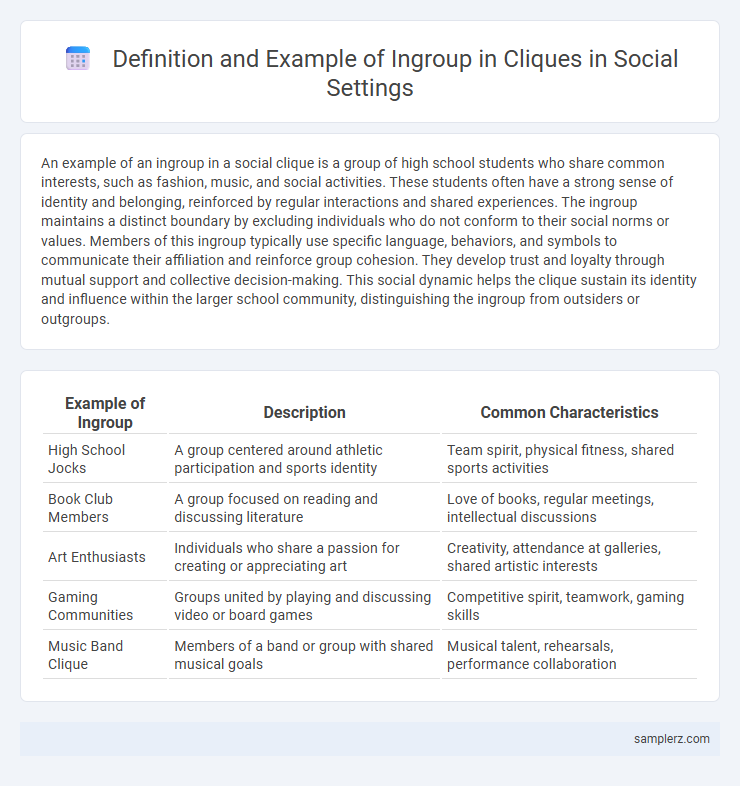An example of an ingroup in a social clique is a group of high school students who share common interests, such as fashion, music, and social activities. These students often have a strong sense of identity and belonging, reinforced by regular interactions and shared experiences. The ingroup maintains a distinct boundary by excluding individuals who do not conform to their social norms or values. Members of this ingroup typically use specific language, behaviors, and symbols to communicate their affiliation and reinforce group cohesion. They develop trust and loyalty through mutual support and collective decision-making. This social dynamic helps the clique sustain its identity and influence within the larger school community, distinguishing the ingroup from outsiders or outgroups.
Table of Comparison
| Example of Ingroup | Description | Common Characteristics |
|---|---|---|
| High School Jocks | A group centered around athletic participation and sports identity | Team spirit, physical fitness, shared sports activities |
| Book Club Members | A group focused on reading and discussing literature | Love of books, regular meetings, intellectual discussions |
| Art Enthusiasts | Individuals who share a passion for creating or appreciating art | Creativity, attendance at galleries, shared artistic interests |
| Gaming Communities | Groups united by playing and discussing video or board games | Competitive spirit, teamwork, gaming skills |
| Music Band Clique | Members of a band or group with shared musical goals | Musical talent, rehearsals, performance collaboration |
Understanding Ingroup Dynamics in Social Cliques
Ingroup dynamics within social cliques often revolve around shared interests, values, and emotional bonds that create a distinct sense of belonging and identity among members. Social psychologists emphasize that ingroups reinforce loyalty and exclusivity through rituals, language, and norms that differentiate members from outsiders. Understanding these dynamics is crucial for analyzing behaviors such as conformity, group cohesion, and social exclusion in interpersonal relationships.
Defining Ingroup: The Core of a Clique
Ingroup within a clique represents the close-knit members who share common interests, values, and social identities, fostering a strong sense of belonging and loyalty. These individuals often set the group's norms and boundaries, reinforcing cohesion and exclusivity. The ingroup's collective identity shapes social interactions, influencing inclusion and exclusion dynamics within the broader social context.
Characteristics of Ingroup Members in Cliques
Ingroup members in cliques often display strong loyalty and shared interests that reinforce group identity, such as similar values, styles, or behaviors. They typically experience high levels of trust and emotional support, fostering a sense of belonging that distinguishes them from outsiders. This closeness is reinforced by frequent interaction and mutual validation within the group.
Social Signals That Mark Ingroup Belonging
Members of a clique often display shared social signals such as distinct slang, specific dress codes, and exclusive hand gestures that mark ingroup belonging. These signals function as nonverbal cues reinforcing group identity and social cohesion within the clique. Consistent use of these markers allows members to quickly identify each other and maintain group boundaries in social settings.
Common Behaviors of Clique Ingroups
Clique ingroups often exhibit exclusive communication patterns, sharing inside jokes and specialized language that reinforce group identity. Members tend to engage in collective activities and display loyalty by supporting each other's opinions and decisions in social settings. These behaviors create a strong sense of belonging and distinguish the clique from outsiders.
Examples of Ingroup Loyalty in Adolescent Cliques
Adolescent cliques often demonstrate ingroup loyalty through exclusive behaviors such as sharing secrets, defending members during conflicts, and maintaining group-specific rituals like inside jokes or designated meeting spots. This loyalty reinforces group identity and fosters a strong sense of belonging among members, which can influence social status and peer acceptance. Examples include standing up for a clique member against outsiders and participating only in activities endorsed by the group.
Role of Ingroups in Clique Hierarchies
Ingroup members within clique hierarchies often assume leadership and gatekeeping roles that enforce group norms and maintain social cohesion. These individuals shape decision-making processes and influence the distribution of social status among peers. Their control over inclusion and exclusion reinforces the clique's boundaries and hierarchy, impacting group dynamics and individual identities.
Friendship Patterns: Identifying the Ingroup
In social cliques, the ingroup typically consists of close-knit friends who share similar interests, values, and behaviors, reinforcing their sense of belonging and exclusivity. Friendship patterns such as mutual support, frequent communication, and shared activities help to identify the ingroup within the larger social network. These patterns strengthen group cohesion and distinguish the ingroup from outsiders, creating clear boundaries based on trust and loyalty.
Stereotypes and Ingroup Identity in Cliques
Members of a popular high school clique often exhibit strong ingroup identity through shared fashion styles and exclusive social behaviors, reinforcing stereotypes that associate them with popularity and superficiality. These stereotypes serve to both solidify the group's cohesion and differentiate the ingroup from outsiders, enhancing feelings of belonging among members. Ingroup pride is maintained by selectively accepting behaviors and attitudes that conform to the clique's established social norms.
Impact of Ingroup Inclusion on Social Experiences
Ingroup inclusion within a clique significantly enhances members' sense of belonging and emotional well-being, fostering a supportive social environment that boosts self-esteem. This inclusion often leads to increased social capital, as individuals gain access to shared resources, information, and group norms that shape behavior and identity. Exclusion from the ingroup, conversely, can result in feelings of isolation and decreased psychological health, highlighting the critical role ingroup dynamics play in social experiences.

example of ingroup in clique Infographic
 samplerz.com
samplerz.com